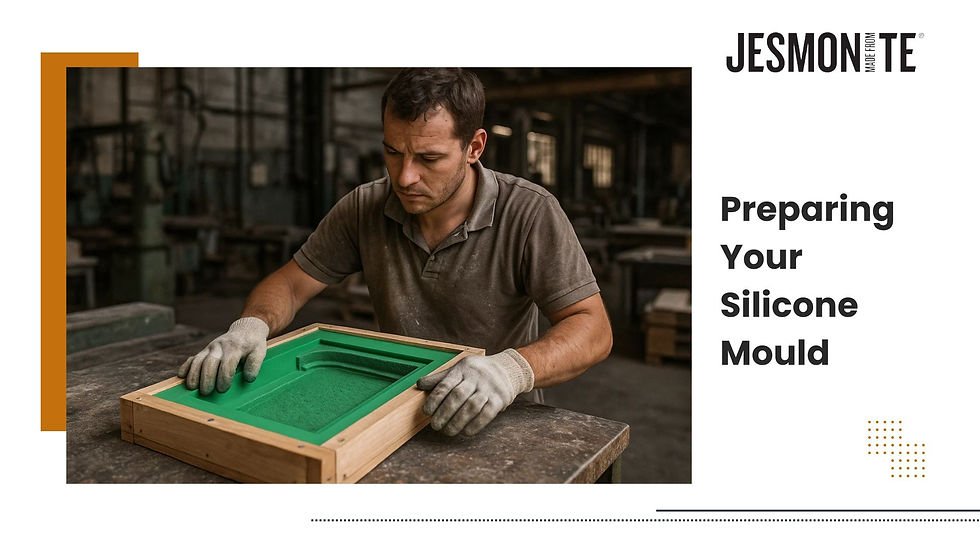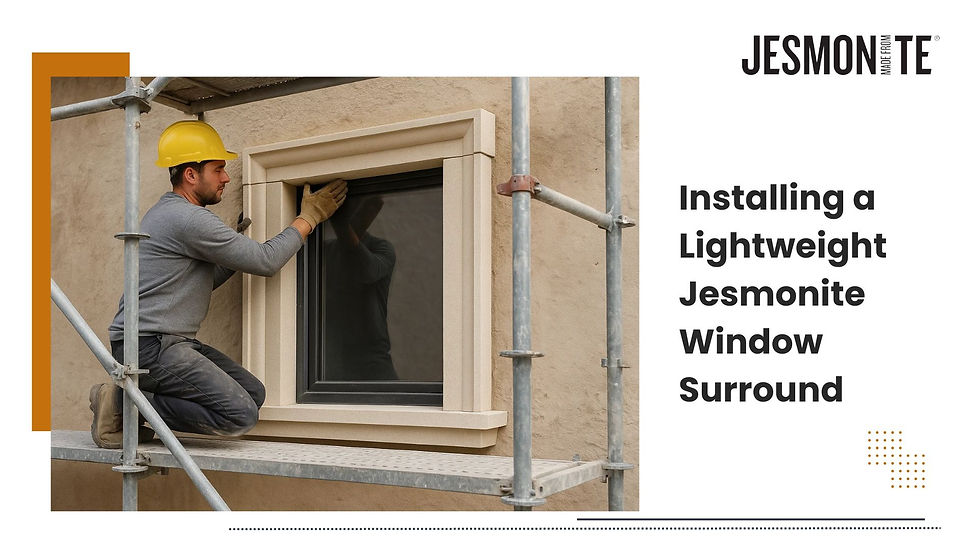How to Cast Stone with Jesmonite Using Silicone Moulds
- Jesmonite

- Jul 10
- 5 min read

A Complete Guide to Creating Lightweight External Architectural Elements
Architectural stone features bring richness, permanence, and sophistication to a building, yet traditional stone is heavy, fragile, and time consuming to install. Whether you're replicating historical details or designing custom pieces for new builds, there's a modern solution that outperforms stone in every practical sense.
Jesmonite AC730, AC830 or AC930, used with silicone moulds, allows makers and manufacturers to recreate stone textures and profiles with precision, durability, and reduced weight. In this guide, we’ll walk you through the full process using a window surround as an example, ideal for residential exteriors, restorations, or architectural statement pieces.
Tools & Materials Checklist
Jesmonite System:
Jesmonite AC730, AC830, AC930 (recommended for outdoor-grade, stone-effect castings)
Jesmonite Colour Matching Service
Jesmonite Sealers (Penetrating or Nano-Sealers)
Mould Setup:
High-grade silicone mould, platinum cure silicone yields best results (custom made or off-the-shelf)
Mould housing or containment box (e.g. plywood)
Digital weighing scales
Mixing buckets
Paddle mixer or high-torque drill with a Jesmonite high sheer mixing blade attachment
Soft bristle brush
Optional Additives:
Jesmonite Flex Metal Gel Coat (for hybrid decorative finishes)
Glass fibre strands or mesh (for extra reinforcement)
Mould release agent if using a rigid mould or surface retarder (Jesmonite APW Wax Available for mould release in rigid moulds)
Vibrating table (to reduce bubbles)
Step 1: Preparing the Silicone Mould
Silicone moulds are flexible, reusable, and perfect for high-detail castings, especially when replicating complex architectural profiles like cornices, pilasters or, in our case, window surrounds.
What to do:
Inspect your mould for dust, damage, or leftover material from previous casts.
Optional - Silicone moulds will release products without a mould release, but some prefer to apply a thin layer of mould release using a brush or cloth to improve de-moulding and extend mould life. A surface retarder can also work in creating a rougher surface for a different finish.
Place the mould on a level surface and brace it inside a containment frame to prevent distortion under weight.
Pro tip: Use moulds with realistic surface imperfections, tool marks, pits, or stone grain for added authenticity.

Step 2: Mixing Jesmonite AC730, AC830 or AC930
Jesmonite AC730 is formulated to mimic the appearance of natural stone, with embedded fine aggregates and a mineral base that accepts pigment beautifully.
Mixing Ratio (by weight):
5 parts base : 1 part liquid - AC730 & AC930
7 parts base : 1 part liquid - AC830
Pigmentation:
Add any further powder pigment to the base powder before combining with liquid.
For natural stone finishes, stick to powdered oxide pigments:
Yellow / buff: warm limestone
Reds: terracotta or claystone
Black + greys: Portland stone, slate, or aged concrete
Mix with a paddle mixer until smooth and lump-free.

Step 3: Pouring and Layering into the Mould
There are two effective techniques for casting Jesmonite into silicone moulds, depending on size and application.
Option A: Face Coat + Backfill (Recommended for Large or Detailed Moulds)
Apply a thin “face/gel/mist coat” (3-5mm) into the mould using a brush or by pouring and spreading gently. Push the mix into recesses and corners.
Allow it to firm slightly, you will see a noticeable reduction in surface sheen as this process occurs, usually 5-10 minutes.
Backfill with remaining Jesmonite mix. Add fibres or mesh as needed.

Option B: Direct Pour (For Smaller or Simpler Pieces)
Pour steadily into one corner and allow the mix to flow naturally allowing the mould to release air bubbles.
Structural tip: For large surrounds, embed mesh or loose chopped strands during the backfill stage for added strength.

Step 4: Curing & De-Moulding
Jesmonite sets quickly, but like any casting material, it continues to gain strength over 24-48 hours.
Wait 3+ hours before de-moulding, depending on ambient conditions.
Carefully remove the mould, starting with corners and working slowly to avoid damage.
Lay the cast flat on a foam surface or raised gridded board to air-cure evenly.
Avoid stacking wet pieces or placing them in direct sunlight to prevent warping and staining.

Step 5: Surface Finishing
Once your cast is fully cured, you can refine the surface with decorative or practical finishes.
Optional Finishing Techniques:
Slurry coat: Fill pinholes with a tinted slurry of Jesmonite and water.
Acid Etching
Shot Blasting
Surface abrasion: Use sandpaper, wire brushes or light acid etching to expose aggregates and soften crisp lines.
Ageing wash: Apply diluted pigments to recesses for a timeworn look.

Sealing:
Use matte or satin sealer with a brush, roller or sprayer.
For exterior installs, ensure the sealant is UV-stable, water-resistant and breathable, all first-party Jesmonite products provide these benefits.
Step 6: Installation – Window Surround Example
Your finished Jesmonite cast can now be fixed to your project location, whether that’s an outdoor facade or interior feature wall.
Substrate:
Acceptable bases include concrete block, cement/render board, ICF (EPS) or rendered wall.
Clean, dry and primed surfaces ensure better adhesion.
Fixing Method:
Apply adhesive, compatible construction glue, or mechanical fixings like stainless steel screws and brackets (always consult an engineer for best fixing advice).
Alignment:
Use temporary props or shims to level the surround as you fix each section.
Leave small gaps (2-5mm) between sections for grout or movement joints.
On-site tip: If joins are visible, use tinted filler or caulk to blend gaps seamlessly.

Why Jesmonite for Cast Stone?
Jesmonite doesn’t just look like stone, it performs better in many key ways:
Property | Jesmonite | Cast Cement | Traditional Stone |
Weight | Lightweight | Approx 25% heavier | Heavy, hard to transport |
Detail replication | High fidelity | Good with limitations | Limited to tool capabilities |
Curing time | 3+ hours | 24-48hrs | 24+ hours |
Weather resistance | Excellent | Good | Variable |
Pigment integration | Internal colouration | Can be added | External only |
Eco credentials | Water-based, sustainable | Medium carbon footprint | High carbon footprint |
Sustainability bonus: Jesmonite is solvent free, made with local materials, and contributes to lower carbon manufacturing footprints.
Common Pitfalls & How to Avoid Them
Issue | Solution |
Air bubbles on surface | Brush face coat into details; tap or vibrate the mould |
Uneven pigment tone | Mix pigments into base first, mix thoroughly |
Fragile corners or edges | Add fibre reinforcement or thicken critical areas |
Mould sticking | Apply consistent mould release; don’t skip this step! |
Cracking during install | Allow full cure (24–48 hours); use flexible adhesive if needed |
Project Inspiration & Adaptation
This method isn’t limited to window surrounds, use the same techniques for:
Cornices and pilasters
Window Surrounds
Full Portico
Fireplace mantels
Wall plaques and medallions
Exterior trims or columns
Garden features and water spouts
Whether you're restoring a listed building or reimagining a modern facade, Jesmonite offers design flexibility without the structural compromises.
A Smarter Way to Build with Stone
Casting architectural elements using Jesmonite and silicone moulds allows you to bypass the limitations of quarried stone, without sacrificing realism. You get:
Faster production
Lighter weight performance
Unmatched detail reproduction
Full creative control over colour and texture
Durability in any environment
From bespoke residential builds to large-scale commercial cladding, this method scales up beautifully. And thanks to Jesmonite’s water-based formulation and sustainability credentials, you’re creating responsibly too.

.png)



Comments